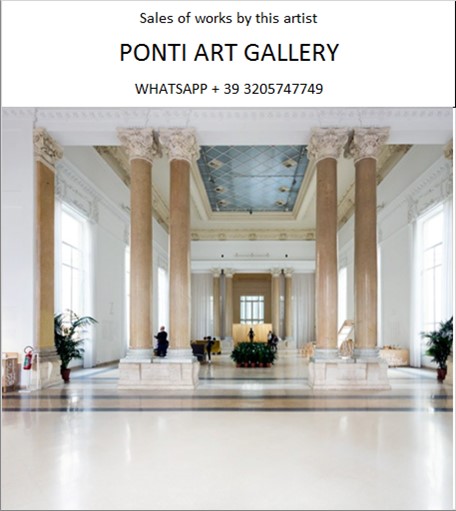Ponti Art Gallery is interested in buying and selling works
of art by this artist.

Henry Moore Biography
Henry Moore, born on July 30, 1898, in Castleford, Yorkshire, England, emerged as one of the most significant British sculptors of the 20th century. His journey from a small mining town to becoming a global icon in the art world is a testament to his pioneering vision and enduring influence on modern sculpture. Moore's work, characterized by its abstract forms, organic shapes, and exploration of the human figure, has left an indelible mark on the landscape of contemporary art.
Moore's early life was steeped in the rugged environment of Yorkshire, which would later influence the organic sensibilities of his work. The seventh of eight children, Moore was born into a working-class family. His father, a miner, was determined that his children would not follow him into the mines and placed a high value on education and advancement. Despite his father's initial opposition to a career in art, considering it akin to manual labor, Moore's passion for sculpture was ignited at a young age. This passion was further fueled by a school lecture on Michelangelo, which Moore credited with his decision to become a sculptor.
Moore's artistic journey began in earnest after his service in World War I, where he was injured at the Battle of Cambrai. Utilizing an ex-serviceman’s grant, he enrolled at Leeds School of Art, becoming the institution's only full-time sculpture student. It was here that Moore met Barbara Hepworth, a fellow student who would become a lifelong friend and professional rival. Moore's exposure to modernism was significantly broadened through access to the private collection of the university vice-chancellor, Sir Michael Sadler, introducing him to the works that would shape his artistic direction.
In 1921, Moore won a scholarship to the Royal College of Art in London, where he delved into the ethnographic collections of the Victoria and Albert Museum and the British Museum. The non-Western art forms he encountered, particularly from ancient Mexico, resonated with Moore, inspiring him to explore themes of abstraction and the human figure in his work. This period marked the beginning of Moore's lifelong fascination with the interplay between form and space, a theme that would define his oeuvre.
Moore's career gained momentum in the 1930s, with his work becoming increasingly abstract and influenced by contemporary movements such as Surrealism. However, it was his experience as an official war artist during World War II, documenting the London Blitz, that brought his work to national prominence. The "Shelter Drawings," depicting Londoners seeking refuge in the Underground, captured the collective trauma of the war and showcased Moore's profound empathy and humanism.
Post-war, Moore's reputation soared, both in Britain and internationally. His sculptures, often monumental in scale and sited in public spaces, became symbols of post-war modernism. Moore's exploration of the reclining figure, mother-and-child motifs, and the relationship between the human form and the landscape resonated with a global audience. His work was celebrated for its ability to convey universal themes of humanity, connection, and resilience.
Throughout his career, Moore remained committed to the principles of direct carving and truth to materials, working in a variety of mediums including bronze, stone, and wood. His approach to sculpture was both innovative and deeply rooted in a reverence for the natural world and the inherent properties of his chosen materials.
Moore's contributions to art were recognized with numerous awards and honors, including the International Prize for Sculpture at the Venice Biennale in 1948. He established the Henry Moore Foundation to support the arts and ensure the preservation of his legacy. Moore continued to work and influence the world of sculpture until his death on August 31, 1986, in Much Hadham, Hertfordshire, England. Today, his work is celebrated worldwide, with sculptures gracing landscapes, museums, and public spaces, testament to his enduring vision and the universal language of his art.
Henry Moore Quotes and Sales
of Works
Ponti Art Gallery selects and deals with paintings by the
artist. Upon request, we provide free estimates and
evaluations, communicate prices, quotations, and current
market values.
If you are interested in BUYING or SELLING works by the
artist, contact us immediately.
If you wish to sell or receive an evaluation of the
works:
Send us a frontal photo of the painting, one of the back,
and one of the signature. Also, indicate the dimensions of
the work. Inform us about the purchase origin of the work
and any kind of available documentation (purchase
receipts, certificates of authenticity, publications). One
of our operators will respond to you on the same day. We
guarantee maximum confidentiality and extreme
professionalism.
If you wish to purchase works by the painter: Contact us
and let us know your request. We will inform you about the
available works. We also offer the possibility to
subscribe to our NEWSLETTER, through which you will be
informed at the beginning of each month about the latest
acquisitions of the art gallery.
You can send us pictures of the work:
